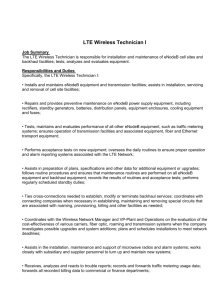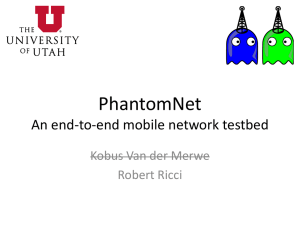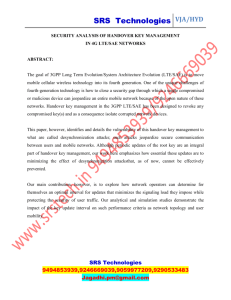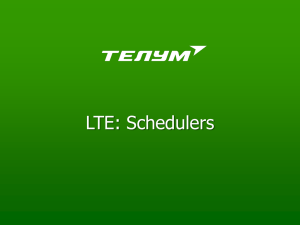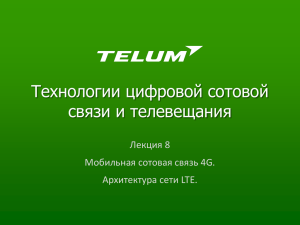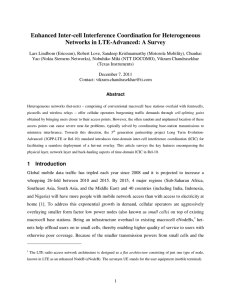Performance Comparison between Round Robin and Proportional
advertisement
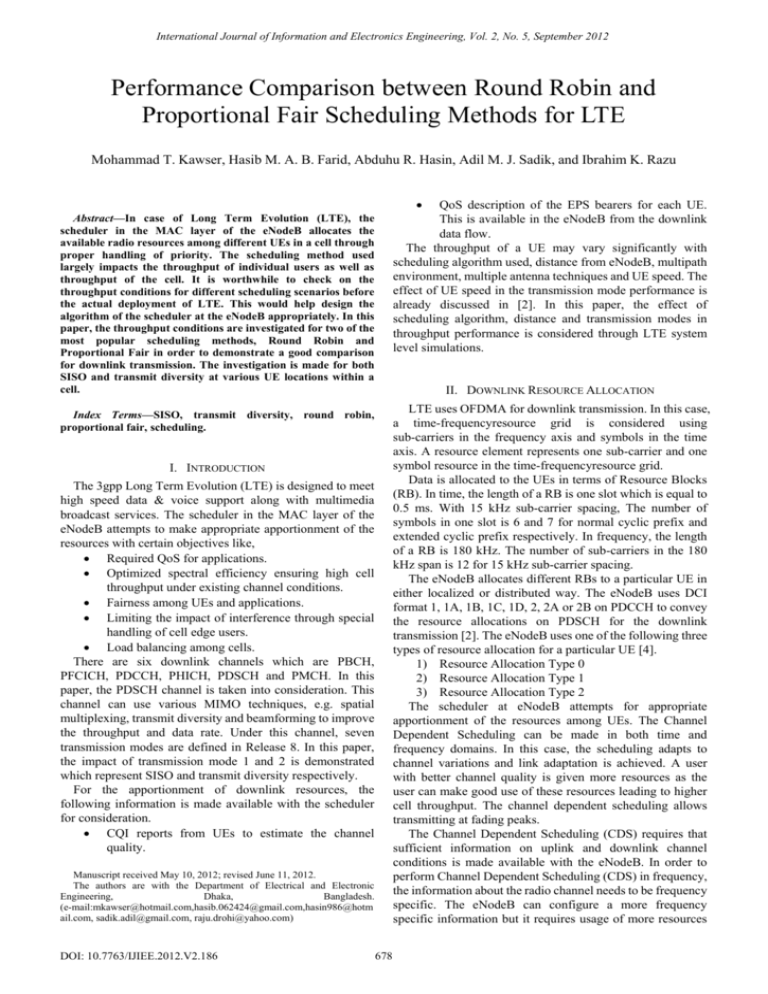
International Journal of Information and Electronics Engineering, Vol. 2, No. 5, September 2012 Performance Comparison between Round Robin and Proportional Fair Scheduling Methods for LTE Mohammad T. Kawser, Hasib M. A. B. Farid, Abduhu R. Hasin, Adil M. J. Sadik, and Ibrahim K. Razu QoS description of the EPS bearers for each UE. This is available in the eNodeB from the downlink data flow. The throughput of a UE may vary significantly with scheduling algorithm used, distance from eNodeB, multipath environment, multiple antenna techniques and UE speed. The effect of UE speed in the transmission mode performance is already discussed in [2]. In this paper, the effect of scheduling algorithm, distance and transmission modes in throughput performance is considered through LTE system level simulations. Abstract—In case of Long Term Evolution (LTE), the scheduler in the MAC layer of the eNodeB allocates the available radio resources among different UEs in a cell through proper handling of priority. The scheduling method used largely impacts the throughput of individual users as well as throughput of the cell. It is worthwhile to check on the throughput conditions for different scheduling scenarios before the actual deployment of LTE. This would help design the algorithm of the scheduler at the eNodeB appropriately. In this paper, the throughput conditions are investigated for two of the most popular scheduling methods, Round Robin and Proportional Fair in order to demonstrate a good comparison for downlink transmission. The investigation is made for both SISO and transmit diversity at various UE locations within a cell. II. DOWNLINK RESOURCE ALLOCATION LTE uses OFDMA for downlink transmission. In this case, a time-frequencyresource grid is considered using sub-carriers in the frequency axis and symbols in the time axis. A resource element represents one sub-carrier and one symbol resource in the time-frequencyresource grid. Data is allocated to the UEs in terms of Resource Blocks (RB). In time, the length of a RB is one slot which is equal to 0.5 ms. With 15 kHz sub-carrier spacing, The number of symbols in one slot is 6 and 7 for normal cyclic prefix and extended cyclic prefix respectively. In frequency, the length of a RB is 180 kHz. The number of sub-carriers in the 180 kHz span is 12 for 15 kHz sub-carrier spacing. The eNodeB allocates different RBs to a particular UE in either localized or distributed way. The eNodeB uses DCI format 1, 1A, 1B, 1C, 1D, 2, 2A or 2B on PDCCH to convey the resource allocations on PDSCH for the downlink transmission [2]. The eNodeB uses one of the following three types of resource allocation for a particular UE [4]. 1) Resource Allocation Type 0 2) Resource Allocation Type 1 3) Resource Allocation Type 2 The scheduler at eNodeB attempts for appropriate apportionment of the resources among UEs. The Channel Dependent Scheduling can be made in both time and frequency domains. In this case, the scheduling adapts to channel variations and link adaptation is achieved. A user with better channel quality is given more resources as the user can make good use of these resources leading to higher cell throughput. The channel dependent scheduling allows transmitting at fading peaks. The Channel Dependent Scheduling (CDS) requires that sufficient information on uplink and downlink channel conditions is made available with the eNodeB. In order to perform Channel Dependent Scheduling (CDS) in frequency, the information about the radio channel needs to be frequency specific. The eNodeB can configure a more frequency specific information but it requires usage of more resources Index Terms—SISO, transmit diversity, round robin, proportional fair, scheduling. I. INTRODUCTION The 3gpp Long Term Evolution (LTE) is designed to meet high speed data & voice support along with multimedia broadcast services. The scheduler in the MAC layer of the eNodeB attempts to make appropriate apportionment of the resources with certain objectives like, Required QoS for applications. Optimized spectral efficiency ensuring high cell throughput under existing channel conditions. Fairness among UEs and applications. Limiting the impact of interference through special handling of cell edge users. Load balancing among cells. There are six downlink channels which are PBCH, PFCICH, PDCCH, PHICH, PDSCH and PMCH. In this paper, the PDSCH channel is taken into consideration. This channel can use various MIMO techniques, e.g. spatial multiplexing, transmit diversity and beamforming to improve the throughput and data rate. Under this channel, seven transmission modes are defined in Release 8. In this paper, the impact of transmission mode 1 and 2 is demonstrated which represent SISO and transmit diversity respectively. For the apportionment of downlink resources, the following information is made available with the scheduler for consideration. CQI reports from UEs to estimate the channel quality. Manuscript received May 10, 2012; revised June 11, 2012. The authors are with the Department of Electrical and Electronic Engineering, Dhaka, Bangladesh. (e-mail:mkawser@hotmail.com,hasib.062424@gmail.com,hasin986@hotm ail.com, sadik.adil@gmail.com, raju.drohi@yahoo.com) DOI: 10.7763/IJIEE.2012.V2.186 678 International Journal of Information and Electronics Engineering, Vol. 2, No. 5, September 2012 as a special case of SU-MIMO Spatial Multiplexing. Transmission Mode 7: Beamforming using UE-Specific Reference Signals The following sections briefly describe the transmission modes which are simulated for evaluation purpose. Transmission Mode 1 This mode uses a single antenna at eNodeB. No diversity is created in transmitted signals. Transmission Mode 2 This mode uses transmit diversity. It is applied using Space-Frequency Block Coding (SFBC) for two transmit antennas and Frequency Switched Transmit Diversity (FSTD) for four transmit antennas. Transmit diversity increases the signal to noise ratio at the receiver instead of directly increasing the data rate. Each transmit antenna transmits essentially the same stream of data and so the receiver gets replicas of the same signal. A suitable signal combining technique reduces fading variation andincreases the signal to noise ratio at the receiver side. Thus, the robustness of data transmission is achieved especially in fading scenarios. An additional antenna-specific coding is applied to the signals before transmission to increase the diversity effect. The transmit diversity this is an open-loop scheme and feedback from the UE feedback is not required. In LTE, transmit diversity is only defined for 2 and 4 transmit antennas and one data stream. To maximize diversity gain, the antennas typically need to be uncorrelated. So, the antennas need to be well separated relative to the wavelength or they need to have different polarization. for this information. Also, the eNodeB can configure the availability of the information more frequently in time so that it can represent the variation of radio channel better but again at the cost of more resources for this information. The UE reports CQI (Channel Quality Indicator) which helps eNodeB estimate the downlink channel quality. The eNodeB can configure if the CQI report would correspond to the whole downlink bandwidth or a part of it which is called sub-band. CQI reporting for different sub-bands requires more uplink resources. The eNodeB can configure CQI reporting in the following ways [4]. Wideband Reporting: The CQI reported corresponds to the whole downlink bandwidth eNodeB Configured Sub-Band Reporting UE Selected Sub-Band Reporting The channel dependent scheduling leads to higher cell throughput and on the other hand, the scheduling should maintain some fairness among the users in their resource allocations. There is a tradeoff between fairness and cell throughput. The scheduler can exercise various methods as shown below in order to address this tradeoff. Round Robin (RR):The scheduler assigns resources cyclically to the users without taking channel conditions into account. This is a simple procedure giving the best fairness. But it would offer poor performance in terms ofcell throughput. Maximum C/I: The scheduler assigns resources to the user with the best channel quality. This offers excellent cell throughput but it is not fair. Proportional Fair (PF): The scheduler can exercise Proportional Fair (PF) scheduling allocating more resources to a user with relatively better channel quality. This offers high cell throughput as well as fairness satisfactorily. Thus, Proportional Fair (PF) scheduling may be the best option. Scheduling for Delay-Limited Capacity: Some applications have very tight latency constraints and so, their QoS require certain guaranteed data rate independent of the fading states. This guaranteed data rate is called delay-limited capacity. The scheduler can allocate resources considering such special requirements. IV. SIMULATION LTE system level simulator [1] was used with parameters shown in the Table I. 20 UEs are placed randomly in one sector of a cell. The throughput has been determined for transmission modes 1 and 2 for rural propagation model. . Performance with round robin and proportional fair scheduling has been observed for four UEs at various distances from the eNodeB andmapping of UEs and eNodeB is depicted in the Table I. A. Mapping of UE and eNodeB within the Cell III. TRANSMISSION MODES PDSCH is configured with one of the following transmission modes according to Release 8 [3]. The choice of transmission mode may depend on the instantaneous radio channel conditions and the transmission mode may be adapted semi-statically. Transmission Mode 1: Using a single antenna at eNodeB Transmission Mode 2: Transmit Diversity Transmission Mode 3: SU-MIMO Spatial Multiplexing: Open-Loop Transmission Mode 4: SU-MIMO Spatial Multiplexing: Closed-Loop Transmission Mode 5: MU-MIMO Spatial Multiplexing Transmission Mode 6: Beamforming using Closed-Loop Rank-1 Precoding: It can also be seen Fig. 1. The comparative distance between eNodeB and UE. Red dot represents eNodeB (Center one is active) and greendot represents UE 679 International Journal of Information and Electronics Engineering, Vol. 2, No. 5, September 2012 TABLE I: SIMULATION PARAMETERS Parameters Assumptions Transmission bandwidth 2.0GHz Inter-site distance 5MHz Thermal noise density 500m Receiver noise figure 9dB Simulation length 5000 TTI UE speeds of interest 5km/hr 20UEs/sector, located in target sector only. UEs position Fig. 4. Simulation result for UE position 3 BS antenna pattern BS antenna gain 15 DBi [1] Round Robin, Proportional Scheduler Fair Thermal noise density -174dBm/Hz TXmode 1, 2 nTX x nRX antennas 2x2 eNodeB TX power 43dBm Subcarrier averaging algorithm Uplink delay Macroscopic model EESM 3TTIs path loss Fig. 5. Simulation result for UE position 4 Rural, given as L=128.1+37.6log10 (R) The above figures depict the comparative throughput performances for two scheduling algorithms. Proportional fair provides the UEs close to the eNodeB with higher throughput for both transmission mode 1 and 2. As the UE moves away from the eNodeB, proportional fair allocates less resource and provide reduced throughput due to weaker radio link. On the other hand, data rate increases for round robin for UEs located further away. For SISO, the data rate is found fairly high in most cases for proportional fair and so, the overall cell throughput is expected to be better with proportional fair. In case of transmit diversity, an improvement of signal to noise ratio is obvious. Thus, at the cell edge, a combination of round robin and transmit diversity achieves very good data rate. B. Simulation Results for Throughput (Mbps) vs TTI (sec). Solid Lines- SISO; Dot-Dash Lines- Transmit Diversity; Green- Proportional Fair; Blue- Round Robin. V. CONCLUSION Fig. 2. Simulation result for UE position 1. In this paper, we analyzed the performances of round robin and proportional fair scheduling methods for two different downlink transmission modes in LTE. Transmit diversity gives better performance for various UE locations within the cell because of its robustness in fading scenarios. However, for different transmission modes, it is found that proportional fair gives very good data rate in most cases. Although round robin gives better individual data rate when the UE is located too far away from eNodeB, the absolute value of this data rate is not that high. Thus, the resources are not then properly utilized and so, proportional fair may still be a better choice. Round robin treats the UE with the best fairness but proportional fair can maintain a balance between fairness and throughput. However, as the results show, the UE is able to Fig. 3. Simulation result for UE position 2. 680 International Journal of Information and Electronics Engineering, Vol. 2, No. 5, September 2012 Hasib M. A. B. Farid is a Lecturer at the Department of Electrical and Electronic Engineering atAhsanullah University of Science and Technology. He has completed his B.Sc. in Electrical and Electronic from Islamic University of Science and Technology in 2010 and doing his M.Sc. in Islamic University of Technology. He was a member of the technical committee of ICCTD 2011. His current research includes various transmission modes and power optimization of LTE. Hasib M. A. B. Farid is a Lecturer at the Department of Electrical and Electronic Engineering atAhsanullah University of Science and Technology. He has completed his B.Sc. in Electrical and Electronic from Islamic University of Science and Technology in 2010 and doing his M.Sc. in Islamic University of Technology. He was a member of the technical committee of ICCTD 2011. His current research includes various transmission modes and power optimization of LTE. improve SNR and make good use of resources when transmit diversity is used. The performance of cell edge users using transmit diversity manifest that the use of round robin scheduling in the cell may not lead to significant sacrifice of cell throughput if transmit diversity is used. REFERENCES [1] [2] [3] [4] LTE System Level Simulator v1.0r295 by Institute Of communication and Radio Frequency Engineering,Vienna University of Technology,Vienna H. Holma and A. ToskalaI, “LTE for UMTS - OFDMA and SC-FDMA Based Radio Access,” John Wiley and Sons, Ltd. 2009. S. Sesia, I. Toufik, and M. Baker, “LTE- the UMTS long term evolution: from theory to practice,” John Wiley & Sons, Ltd. 2009. 3GPP Technical Specification 36.213, “Evolved Universal Terrestrial Radio Access (E-UTRA): Physical Layer Procedures.” [Online]. Available: 3gpp http:// www.3gpp.org Abduhu. R. Hasin is a Lecturer (on leave) at the Electrical and Electronic Engineering Department at Islamic University of Technology in Bangladesh. He has completed his B.Sc. in Electrical and Electronic from Islamic University of Science and Technology in 2009 and doing his M.Sc. in Arizona State University, Tempe, Arizona. His current research is on Wireless Communication. Mohammad T. Kawser is an Assistant Professor at the Electrical and Electronic Engineering Department at Islamic University of Technology in Bangladesh. Previously, he served as a Senior RF and Tools Engineer at Accuver Americas (formerly, WirelessLogix, Inc.), Texas. He received an M.S. from Virginia Tech in 2005 and a B.S. from Bangladesh University of Engineering and Technology, Bangladesh, in 1999, both in electrical engineering. He is a member of the editorial boards for the International Journal of Computer and Electrical Engineering (IJCEE) and the International Journal of Computer Theory and Engineering (IJCTE). His current research area includes various processes in access stratum of Long Term Evolution. Adil M. J. Sadik has completed his B.Sc. in Electrical and Electronic from Islamic University of Science and Technology in 2009 and doing his M.Sc. in at Columbia University in the City of New York in Computer Engineering. His current research is on Embedded System. Ibrahim K. Razu is working as an Engineer in ORASCOM Telecom Bangladesh Ltd. He has completed his B.Sc. in Electrical and Electronic from Islamic University of Science and Technology in 2010 and his current research is on Wireless Communication. 681
